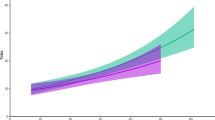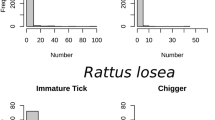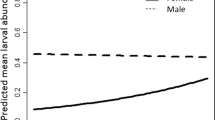Abstract
In mammalian hosts, macroparasite aggregation is highly heterogeneous over space and time and among individuals. While the exact causes of this heterogeneity remain unclear, it has mainly been attributed to individual differences in exposure and susceptibility. Although some extrinsic (e.g., parasite availability) and intrinsic (e.g., sex or age) factors are well known to affect infestation patterns, the joint and possibly interacting effects of these factors are poorly understood. Here, we study the infestation of hard ticks (mainly Ixodes ricinus) in a small rodent, the Siberian chipmunk (Tamias sibiricus), introduced to an oak-hornbeam forest in France. We investigate the seasonal variation in infestation according to the sex, age, birth season (spring-born or summer-born), and body weight of individual hosts while controlling for interannual variability. During the 10-year study period, 3421 tick count events were recorded involving 1017 chipmunks monitored by the capture-mark-recapture procedure. Our results reveal a male-biased parasitism in the Siberian chipmunk, which is not consistent among individuals born in different seasons. This sex bias is observed among spring-born juveniles from July to the beginning of hibernation. For adults, this difference becomes apparent along the reproduction period (May–September) for summer-born adults only. These complex interactions between sex, age, and birth season suggest overall that the seasonal variation of tick load is critically linked to the reproductive behavior of this small ground sciurid.



Similar content being viewed by others
References
Altizer S, Nunn CL, Thrall PH et al (2003) Social organization and parasite risk in mammals: integrating theory and empirical studies. Annu Rev Ecol Evol Syst 34:517–547. doi:10.1146/annurev.ecolsys.34.030102.151725
Anderson RM, May RM (1978) Regulation and stability of host-parasite population interactions: I. Regulatory processes. J Anim Ecol 47:219–247
Bartoń KA (2013) MuMIn—R package for model selection and multi-model inference
Bates D, Maechler M, Bolker B et al (2014) Package “lme4.”
Bordes F, Morand S, Kelt DA, Van Vuren DH (2009) Home range and parasite diversity in mammals. Am Nat 173:467–474. doi:10.1086/597227
Boyer N, Réale D, Marmet J et al (2010) Personality, space use and tick load in an introduced population of Siberian chipmunks Tamias sibiricus. J Anim Ecol 79:538–547. doi:10.1111/j.1365-2656.2010.01659.x
Brossard M, Wikel SK (2004) Tick immunobiology. Parasitology 129:S161–S176. doi:10.1017/S0031182004004834
Brunner JL, Ostfeld RS (2008) Multiple causes of variable tick burdens on small-mammal hosts. Ecology 89:2259–2272
Burnham K, Anderson D (2002) Model selection and multi-model inference: a practical information-theoretic approach, 2nd edition. 1–515
Burns C, Goodwin B, Ostfeld R (2005) A prescription for longer life? Bot fly parasitism of the white-footed mouse. Ecology 86:753–761
Calabrese JM, Brunner JL, Ostfeld RS (2011) Partitioning the aggregation of parasites on hosts into intrinsic and extrinsic components via an extended Poisson-gamma mixture model. PLoS One 6:e29215. doi:10.1371/journal.pone.0029215
Careau V, Thomas D, Humphries M (2010) Energetic cost of bot fly parasitism in free-ranging eastern chipmunks. Oecologia 162:303–312. doi:10.1007/s00442-009-1466-y
Chapuis J-L (2005) Répartition en France d’un animal de compagnie naturalisé, le Tamia de Sibérie (Tamias sibiricus). Rev Ecol (Terre Vie) 60:239–254
Chapuis J-L, Obolenskaya EV, Pisanu B, Lissovsky AA (2011) Datasheet on Tamias sibiricus. CABI, Wellingford, UK (http://www.cabi.org/isc/)
Dallas TA, Foré SA, Kim H-J (2012) Modeling the influence of Peromyscus leucopus body mass, sex, and habitat on immature Dermacentor variabilis burden. J Vector Ecol 37:338–341. doi:10.1111/j.1948-7134.2012.00236.x
Degen AA (2006) Effect of macroparasites on the energy budget of small mammals. In: Springer-Japan (ed) Micromammals and macroparasites. pp 371–399
Dlugosz EM, Downs CJ, Khokhlova IS et al (2014) Ectoparasite performance when feeding on reproducing mammalian females: an unexpected decrease when on pregnant hosts. J Exp Biol 217:1058–1064. doi:10.1242/jeb.098376
Fitze PS, Tschirren B, Richner H (2004) Life history and fitness consequences of ectoparasites. J Anim Ecol 73:216–226
Folstad I, Karter AJ (1992) Parasites, bright males, and the immunocompetence handicap. Am Nat 139:603–622
Frank DH, Heske EJ (1992) Seasonal changes in space use patterns in the southern grasshopper mouse, Onychomys torridus torridus. J Mammal 73:292–298
Gooderham K, Schulte-Hostedde A (2011) Macroparasitism influences reproductive success in red squirrels (Tamiasciurus hudsonicus). Behav Ecol 22:1195–1200. doi:10.1093/beheco/arr112
Greenwood PJ (1980) Mating systems, philopatry and dispersal in birds and mammals. Anim Behav 28:1140–1162
Harrison A, Scantlebury M, Montgomery IW (2010) Body mass and sex-biased parasitism in wood mice Apodemus sylvaticus. Oikos 119:1099–1104. doi:10.1111/j.1600-0706.2009.18072.x
Hughes VL, Randolph SE (2001) Testosterone depresses innate and acquired resistance to ticks in natural rodent hosts: a force for aggregated distributions of parasites. J Parasitol 87:49–54
Kawamichi T, Kawamichi M (1993) Gestation period and litter size of Siberian chipmunk Eutamias sibiricus lineatus in Hokkaido, northern Japan. J Mammal Soc Jpn 18:105–109
Keesing F, Belden LK, Daszak P et al (2010) Impacts of biodiversity on the emergence and transmission of infectious diseases. Nature 468:647–652. doi:10.1038/nature09575
Kiffner C, Vor T, Hagedorn P et al (2011) Factors affecting patterns of tick parasitism on forest rodents in tick-borne encephalitis risk areas, Germany. Parasitol Res 108:323–335. doi:10.1007/s00436-010-2065-x
Kiffner C, Stanko M, Morand S et al (2013) Sex-biased parasitism is not universal: evidence from rodent-flea associations from three biomes. Oecologia 173:1009–1022. doi:10.1007/s00442-013-2664-1
Kovár L (2004) Tick saliva in anti-tick immunity and pathogen transmission. Folia Microbiol (Praha) 49:327–336
Krasnov BR, Morand S, Hawlena H et al (2005) Sex-biased parasitism, seasonality and sexual size dimorphism in desert rodents. Oecologia 146:209–217. doi:10.1007/s00442-005-0189-y
Krasnov BR, Bordes F, Khokhlova IS, Morand S (2012) Gender-biased parasitism in small mammals: patterns, mechanisms, consequences. Mammalia 76:1–13. doi:10.1515/mammalia-2011-0108
Marmet J (2008) Traits d’histoire de vie du Tamia de Sibérie Tamias sibiricus, espèce exotique naturalisée dans la forêt de Sénart (Essonne): démographie, biologie de la reproduction, occupation de l’espace et dispersion. Dissertation, Muséum National d’Histoire Naturelle
Marmet J, Pisanu B, Chapuis J-L (2009) Home range, range overlap, and site fidelity of introduced Siberian chipmunks in a suburban French forest. Eur J Wildl Res 55:497–504. doi:10.1007/s10344-009-0266-3
Marmet J, Pisanu B, Chapuis J-L (2011) Natal dispersal of introduced Siberian chipmunks, Tamias sibiricus, in a suburban forest. J Ethol 29:23–29. doi:10.1007/s10164-010-0215-3
Marmet J, Pisanu B, Chapuis J-L et al (2012) Factors affecting male and female reproductive success in a chipmunk (Tamias sibiricus) with a scramble competition mating system. Behav Ecol Sociobiol 66:1449–1457. doi:10.1007/s00265-012-1399-z
Marsot M, Sigaud M, Chapuis J-L et al (2011) Introduced Siberian chipmunks (Tamias sibiricus barberi) harbor more-diverse Borrelia burgdorferi sensu lato genospecies than native bank voles (Myodes glareolus). Appl Environ Microbiol 77:5716–5721. doi:10.1128/AEM. 01846-10
Marsot M, Chapuis J-L, Gasqui P et al (2013) Introduced Siberian chipmunks (Tamias sibiricus barberi) contribute more to Lyme borreliosis risk than native reservoir rodents. PLoS One 8:e55377. doi:10.1371/journal.pone.0055377
Miller MR, White A, Wilson K, Boots M (2007) The population dynamical implications of male-biased parasitism in different mating systems. PLoS One 2:e624. doi:10.1371/journal.pone.0000624
Moller AP (1993) Ectoparasites increase the cost of reproduction in their hosts. J Anim Ecol 62:309–322. doi:10.2307/5362
Moore SL, Wilson K (2002) Parasites as a viability cost of sexual selection in natural populations of mammals. Science 297:2015–2018. doi:10.1126/science.1074196
Neuhaus P (2003) Parasite removal and its impact on litter size and body condition in Columbian ground squirrels (Spermophilus columbianus). Proc Biol Sci 270:S213–S215. doi:10.1098/rsbl.2003.0073
Obolenskaya EV, Lee M-Y, Dokuchaev NE et al (2009) Diversity of Palaearctic chipmunks (Tamias, Sciuridae). Mammalia 73:281–298. doi:10.1515/MAMM.2009.047
Patterson JEH, Neuhaus P, Kutz SJ, Ruckstuhl KE (2013) Parasite removal improves reproductive success of female North American red squirrels (Tamiasciurus hudsonicus). PLoS One 8:e55779. doi:10.1371/journal.pone.0055779
Pinheiro JC, Bates DM (2000) Mixed-effects models in S and S-PLUS. Springer
Pisanu B, Marsot M, Marmet J et al (2010) Introduced Siberian chipmunks are more heavily infested by ixodid ticks than are native bank voles in a suburban forest in France. Int J Parasitol 40:1277–1283. doi:10.1016/j.ijpara.2010.03.012
Pisanu B, Obolenskaya EV, Baudry E et al (2013) Narrow phylogeographic origin of five introduced populations of the Siberian chipmunk Tamias (Eutamias) sibiricus (Laxmann, 1769) (Rodentia: Sciuridae) established in France. Biol Invasions 15:1201–1207. doi:10.1007/s10530-012-0375-x
Poulin R, Krasnov BR, Morand S (2006) Patterns of host specificity in parasites exploiting small mammals. In: Springer-Japan (ed) Micromammals and macroparasites. pp 233–256
R Core Team (2014) R: a language and environment for statistical computing
Randolph SE (2004) Tick ecology: processes and patterns behind the epidemiological risk posed by ixodid ticks as vectors. Parasitology 129:S37–S65. doi:10.1017/S0031182004004925
Randolph SE, Storey K (1999) Impact of microclimate on immature tick-rodent host interactions (Acari: Ixodidae): implications for parasite transmission. J Med Entomol 36:741–748
Randolph SE, Green RM, Hoodless AN, Peacey M (2002) An empirical quantitative framework for the seasonal population dynamics of the tick Ixodes ricinus. Int J Parasitol 32:979–989. doi:10.1016/S0020-7519(02)00030-9
Roff DA (1992) Evolution of life histories: theory and analysis, Springer
Rolff J (2002) Bateman’s principle and immunity. Proc Biol Sci 269:867–872. doi:10.1098/rspb.2002.1959
Rosà R, Pugliese A, Ghosh M et al (2007) Temporal variation of Ixodes ricinus intensity on the rodent host Apodemus flavicollis in relation to local climate and host dynamics. Vector Borne Zoonotic Dis 7:285–295. doi:10.1089/vbz.2006.0607
Shaw DJ, Grenfell BT, Dobson AP (1998) Patterns of macroparasite aggregation in wildlife host populations. Parasitology 117:597–610
Shier DM, Randall JA (2004) Spacing as a predictor of social organization in kangaroo rats (Dipodomys heermanni arenae). J Mammal 85:1002–1008
Stearns SC (1992) The evolution of life histories. Oxford University Press, Oxford
Tschirren B, Bischoff LL, Saladin V, Richner H (2007) Host condition and host immunity affect parasite fitness in a bird-ectoparasite system. Funct Ecol 21:372–378. doi:10.1111/j.1365-2435.2007.01235.x
Vourc’h G, Marmet J, Chassagne M et al (2007) Borrelia burgdorferi Sensu Lato in Siberian chipmunks (Tamias sibiricus) introduced in suburban forests in France. Vector Borne Zoonotic Dis 7:637–641. doi:10.1089/vbz.2007.0111
Wickham H (2009) ggplot2: elegant graphics for data analysis, Springer
Wikel SK, Whelen AC (1986) Ixodid-host immune interaction. Identification and characterization of relevant antigens and tick-induced host immunosuppression. Vet Parasitol 20:149–174
Wilson K, Bjørnstad ON, Dobson AP et al (2002) Heterogeneities in macroparasite infections: patterns and processes. In: Oxford: Oxford University Press (ed) Ecol. Wildl. Dis. pp 6–44
Woolhouse MEJ, Dye C, Etard J-F et al (1997) Heterogeneities in the transmission of infectious agents: implications for the design of control programs. Proc Natl Acad Sci U S A 94:338–342
Zuk M, Stoehr AM (2002) Immune defense and host life history. Am Nat 160:S9–S22. doi:10.1086/342131
Zuur AF, Ieno EN, Elphick CS (2010) A protocol for data exploration to avoid common statistical problems. Methods Ecol Evol 1:3–14. doi:10.1111/j.2041-210X.2009.00001.x
Acknowledgments
We thank the National Forests Office (Office National des Forêts, France) for the financial support and for allowing fieldwork in the site ‘La Faisanderie’ (Forest of Sénart, France). This work was also funded by the Conseil Régional d’Ile-de-France, the Conseil Général des Hauts-de-Seine and the Ministère de l’Ecologie, du Développement durable et de l’Energie (MEDDE). We are thankful to J. Marmet for her contribution in the mark-recapture monitoring and tick counts from 2005 to 2007.
Compliance with ethical standards
All procedures performed in studies involving animals were in accordance with the ethical standards of the institutional ethics committee at the MNHN (#6810 Comité Cuvier) at which the studies were conducted.
Author information
Authors and Affiliations
Corresponding author
Rights and permissions
About this article
Cite this article
Le Coeur, C., Robert, A., Pisanu, B. et al. Seasonal variation in infestations by ixodids on Siberian chipmunks: effects of host age, sex, and birth season. Parasitol Res 114, 2069–2078 (2015). https://doi.org/10.1007/s00436-015-4391-5
Received:
Accepted:
Published:
Issue Date:
DOI: https://doi.org/10.1007/s00436-015-4391-5




